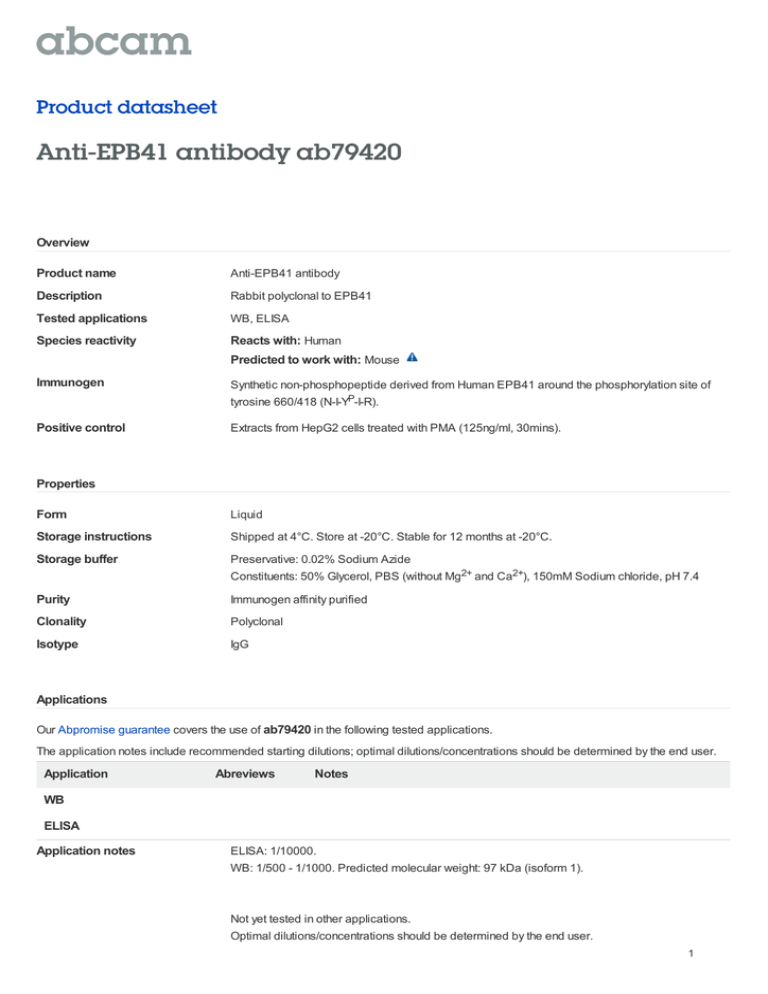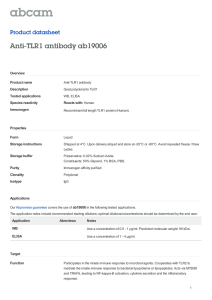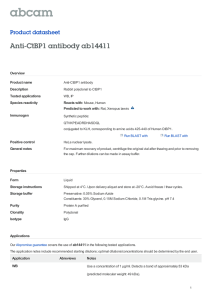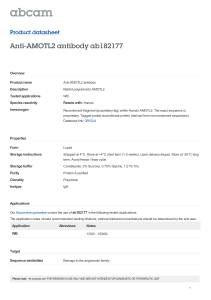Anti-EPB41 antibody ab79420 Product datasheet
advertisement

Product datasheet Anti-EPB41 antibody ab79420 Overview Product name Anti-EPB41 antibody Description Rabbit polyclonal to EPB41 Tested applications WB, ELISA Species reactivity Reacts with: Human Predicted to work with: Mouse Immunogen Synthetic non-phosphopeptide derived from Human EPB41 around the phosphorylation site of tyrosine 660/418 (N-I-YP-I-R). Positive control Extracts from HepG2 cells treated with PMA (125ng/ml, 30mins). Properties Form Liquid Storage instructions Shipped at 4°C. Store at -20°C. Stable for 12 months at -20°C. Storage buffer Preservative: 0.02% Sodium Azide Constituents: 50% Glycerol, PBS (without Mg2+ and Ca2+), 150mM Sodium chloride, pH 7.4 Purity Immunogen affinity purified Clonality Polyclonal Isotype IgG Applications Our Abpromise guarantee covers the use of ab79420 in the following tested applications. The application notes include recommended starting dilutions; optimal dilutions/concentrations should be determined by the end user. Application Abreviews Notes WB ELISA Application notes ELISA: 1/10000. WB: 1/500 - 1/1000. Predicted molecular weight: 97 kDa (isoform 1). Not yet tested in other applications. Optimal dilutions/concentrations should be determined by the end user. 1 Target Function Protein 4.1 is a major structural element of the erythrocyte membrane skeleton. It plays a key role in regulating membrane physical properties of mechanical stability and deformability by stabilizing spectrin-actin interaction. Recruits DLG1 to membranes. Involvement in disease Defects in EPB41 are the cause of elliptocytosis type 1 (EL1) [MIM:611804]. EL1 is a Rhesuslinked form of hereditary elliptocytosis, a genetically heterogeneous, autosomal dominant, hematologic disorder. It is characterized by variable hemolytic anemia and elliptical or oval red cell shape. Defects in EPB41 are a cause of hereditary pyropoikilocytosis (HPP) [MIM:266140]. HPP is an autosomal recessive hematologic disorder characterized by hemolytic anemia, microspherocytosis, poikilocytosis, and an unusual thermal sensitivity of red cells. Sequence similarities Contains 1 FERM domain. Post-translational modifications Phosphorylated at multiple sites by different protein kinases and each phosphorylation event selectively modulates the protein's functions. Phosphorylation on Tyr-660 reduces the ability of 4.1 to promote the assembly of the spectrin/actin/4.1 ternary complex. O-glycosylated; contains N-acetylglucosamine side chains in the C-terminal domain. Cellular localization Cytoplasm > cytoskeleton. Cytoplasm > cell cortex. Nucleus. Please note: All products are "FOR RESEARCH USE ONLY AND ARE NOT INTENDED FOR DIAGNOSTIC OR THERAPEUTIC USE" Our Abpromise to you: Quality guaranteed and expert technical support Replacement or refund for products not performing as stated on the datasheet Valid for 12 months from date of delivery Response to your inquiry within 24 hours We provide support in Chinese, English, French, German, Japanese and Spanish Extensive multi-media technical resources to help you We investigate all quality concerns to ensure our products perform to the highest standards If the product does not perform as described on this datasheet, we will offer a refund or replacement. For full details of the Abpromise, please visit http://www.abcam.com/abpromise or contact our technical team. Terms and conditions Guarantee only valid for products bought direct from Abcam or one of our authorized distributors 2


![Anti-SCF antibody [1.2_2H5-1C10] ab17482 Product datasheet Overview Product name](http://s2.studylib.net/store/data/012512210_1-7f6f843287d5ab7338411d5cede2de30-300x300.png)

